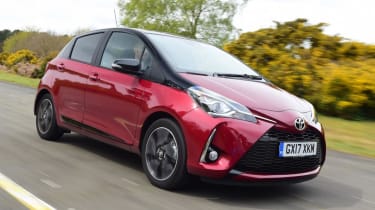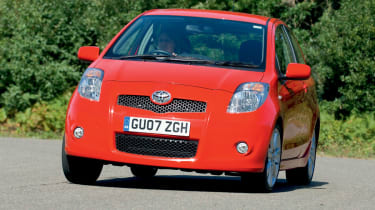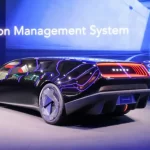
Toyota has decided that the key qualities for its Yaris supermini are stylish design, good fuel economy and plenty of kit thrown in as standard. It’s a convincing package, but one that can’t offer the practical space or fun driving dynamics of the best in this class.
The fourth-generation Yaris is a great performer around town, and certainly won’t be caught out on motorway stretches. However, high prices could prove to be a stumbling block and the dull cabin doesn’t do justice to the cool-looking exterior.
About the Toyota Yaris
It’s easy to see why the marvellous GR Yaris hot hatch holds so much appeal for keen drivers, but the regular version of Toyota’s Yaris supermini should be lauded as arguably the most focused yet. As a pioneer of hybrid technology, the Japanese brand has concentrated on delivering an increasingly green range. To this end, while most car makers continue to offer petrol and diesel vehicles in their line-ups, the Yaris now features a single petrol-hybrid powertrain.
Rivals such as the Vauxhall Corsa, Peugeot 208, Hyundai i20 and Volkswagen Polo provide myriad engine and trim combinations, although customers considering the Yaris might also be drawn towards the Renault Clio E-Tech or Honda Jazz which feature similar hybrid set-ups.
In an ultra-competitive supermini market, the five-door Yaris (our 2022 Affordable Hybrid Car of the Year) is keeping things simple. The sole 1.5-litre petrol hybrid engine delivers 114bhp and provides more than enough power to make it a capable performer around town.
Toyota claims the hybrid model’s bigger battery will help it function in pure electric mode for around 80 per cent of the time while on regular urban journeys, and it can be driven at up to 80mph before the petrol engine imperceptibly chips-in to support smooth progress.
The dimensions of this Yaris have actually shrunk compared to the previous model, with overall length slightly reduced and a lower roofline than before. The effect is a sporty, more muscular look, with the metallic and pearlescent bi-tone paint finishes particularly striking.
Standard equipment for the Yaris is pretty comprehensive, with the entry Icon trim including 16-inch alloy wheels, automatic headlights and wipers, adaptive cruise control, air-con, a 7.0-inch infotainment touchscreen and Android Auto and Apple CarPlay smartphone connectivity. Mid-spec Design adds extra kit such as LED headlights, privacy glass and a bigger infotainment screen, while GR Sport and Excel specifications sit at the top of the price list.
Starting from around £22,000 at the time of writing, the Yaris is generally more expensive than its combustion-engined rivals, although it sits between the starting prices of the similarity electrified Honda Jazz and Renault Clio E-Tech.
Used and nearly new
Ever since Toyota arrived in the UK more than half a century ago, it’s offered cars that focus on reliability rather than excitement. It’s a strategy that’s served the firm very well, with buyers returning time after time, safe in the knowledge that their car is unlikely to let them down.
That’s certainly true of the Yaris, the first generation of which appeared in 1999. With light controls and an easy driving experience, this supermini provided quality and economy with a healthy dose of practicality. It’s a formula Toyota has stuck with right up to the latest Mk4 car.
Toyota Yaris history

Toyota Yaris Mk4: 2020-
Toyota has decided that the key qualities for its Yaris supermini are stylish design, good fuel economy and plenty of kit thrown in as standard. It’s a convincing package, but one that can’t offer the practical space or fun driving dynamics of the best rivals. The Yaris is a great performer around town, and certainly won’t be caught out on motorway stretches. However, high prices could prove to be a stumbling block and the dull cabin doesn’t do justice to the cool-looking exterior.

Toyota Yaris Mk3: 2011-2020
The Yaris Mk3 enjoyed nearly a decade of production, during which time it cemented a reputation for reliability and efficiency. Key to this was the availability of a Yaris Hybrid, which delivered diesel-like economy in the city. There was even a diesel option, which is a great used buy for anyone searching for a supermini to take on long trips. Late versions of the Yaris Mk3 should still be covered by Toyota’s five-year/100,000-mile warranty. Read our full Mk3 Toyota Yaris buyer’s guide here…

Toyota Yaris Mk2: 2006-2011
Launched in 2006, the Yaris Mk2 picked up where the old Yaris left off by offering a compelling blend of efficiency, reliability and practicality. Supermini buyers in search of fun should look elsewhere, because the Yaris Mk2 is unexciting to drive, especially if you opt for the entry-level 1.0 three-cylinder petrol engine.
Older Toyota Yaris models
Following its production debut at the 1998 Paris Motor Show, the Toyota Yaris (Vitz in its domestic market) went on sale in 1999. Available as a three- or five-door hatchback, the Yaris replaced the Starlet and featured a central instrument panel and best-in-class safety and environmental credentials. The award-winning 1.0-litre 16-valve petrol engine delivered the performance of a 1.4-litre engine and was named International Engine of the Year in 1999.
For an alternative review of the Toyota Yaris, visit our sister site carbuyer.co.uk…





